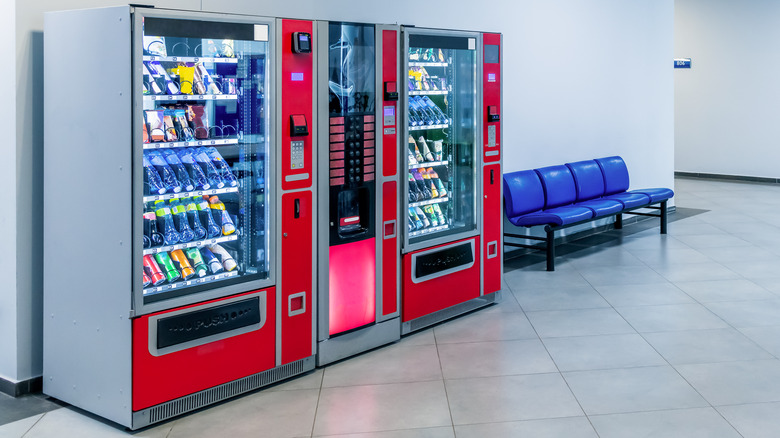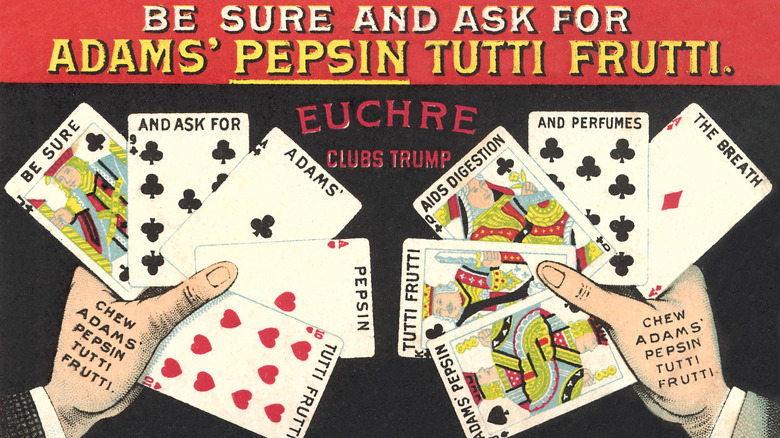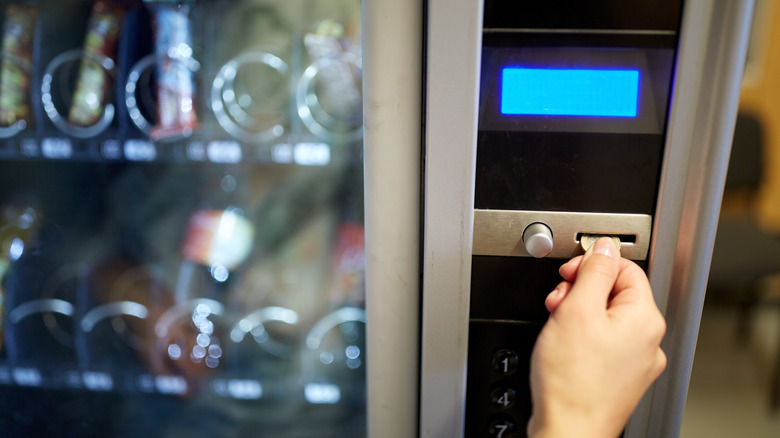What Was Sold In The Very First Food Vending Machine?
Food vending machines are ubiquitous; we expect there will be one nearby when in need of a candy sugar rush, the salty fix of a bag of chips, or even a pre-packaged sandwich on the go. We depend on vending machines to stand by with cold cans of soda or hot coffee brewed on demand. Whether working in an office or factory, staying at a hotel, in a repair shop, hospital waiting room, or rushing between classes, we can typically rely on the convenience of a vending machine to satisfy our hunger, thirst, or craving — but it wasn't always so. Tracing back to the very first food sold in vending machines leads to a surprising beginning: chewing gum.
In 1822, an Englishman invented the first modern vending machine, which distributed newspapers and banned political books. It wasn't until more than half a century later that a man named Thomas Adams installed the first food vending machines in New York's subway system. The machines sold sticks of his Tutti-Frutti gum for a penny a pop.
Had it not been for Adams' encounter with an exiled Mexican president in Staten Island, we might have never had chewing gum or vending machines as we know them. The chance meeting of these two men led to revolutionizing the food manufacturing and vending trades. To understand how these diverse businesses became multibillion-dollar industries, we need to look at the fascinating food history of why chewing gum came to be sold in vending machines.
How food vending machines got on the subway
Chewing gum's origins trace back to the Mayans and Aztecs who harvested flavorless sap called chicle from the sapodilla tree to chew on. In 1867, Thomas Adams acquired a surplus of chicle from the same Mexican general who had sacked the Alamo. Adams transformed the chewy resin into the first retail chewing gum made of chicle. The new gum was a vast improvement on the crumbly paraffin wax sold as gumballs at the time.
With his gum in high demand, Adams sought ways to expand his burgeoning gum empire. He patented the world's first food vending machines and in 1888 had them installed on the platforms of New York City's subways. These coin-operated dispensers were stocked with a fruit-flavored gum called Tutti Frutti, along with another bestseller, Black Jack, which tasted like licorice.
Putting gum vending machines in subway stations turned out to be a brilliant marketing tactic that sent sales skyrocketing and started a full-on gum chewing craze, as well as launched countless vending machine variations. Gum was non-perishable and inexpensive to produce, giving it the reputation of being a less hoity-toity snack that anyone could enjoy on the go. Subway riders loved the novelty of being able to make a quick impulse buy while waiting for their trains. They could purchase a stick of gum by dropping one cent into the wooden machine's slot, pull the lever, and watch in delight as their gum dropped out the bottom.
Vending machine history from Tutti Frutti to high tech
The first rudimentary vending machines broke down frequently, and were prey to thieves who used fake coin slugs to trick the devices into doling out the goods without payment. These primitive machines were a far cry from the ultra-modern, digital touchscreen Japanese vending machines, or the fresh egg vending machines which exist today.
The vestiges of the first food vending machines have morphed into the stalwarts of self-serve we now count on for snacks-on-demand. The path from selling sticks of gum on NYC subways to Coke and candy being available on nearly every corner the world over is one of innovation, business savvy, and technological breakthroughs. Let's connect the dots.
Following the success of Adam's first food vending machine, the concept took off. 1893 saw the first vending machine to dispense chocolate, along with soap and cigarettes. Next came machines that spat out paper cups and filled them with soda, which then led to the introduction in 1929 of Coca-Cola vending machines that offered the cold beverage in glass bottles. 1946 brought coffee vending machines into popular culture, followed in 1950 by sandwiches and similar prepared foods that required refrigeration. Now considered to be antique collectibles, Thomas Adams' original vending machines can be found at auctions selling for thousands of dollars. How times have changed!



